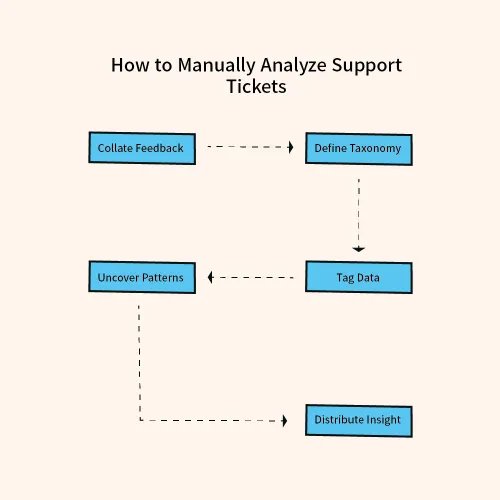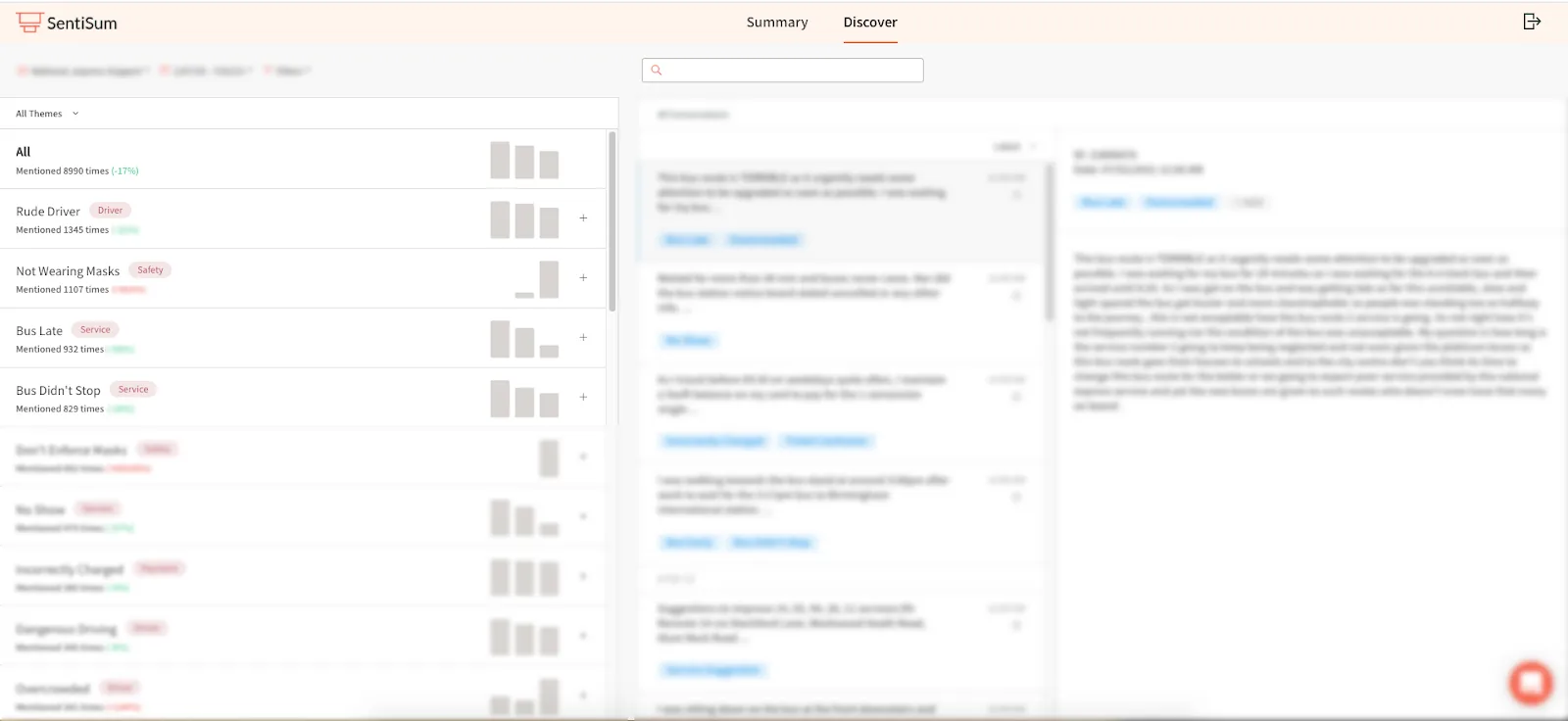Customer complaints are an inevitable part of doing business, but how you handle and learn from them determines whether they become a risk—or an opportunity. Complaints often signal unmet expectations across product quality, service, communication, or processes. Instead of viewing them as setbacks, smart companies use complaints as a powerful feedback loop to strengthen customer relationships, reduce churn, and drive long-term loyalty.
In this blog, we’ll explore the root causes of customer complaints, strategies to reduce them, and practical frameworks, supported by AI-driven tools like SentiSum, to turn customer frustration into actionable insights and lasting improvements.
TL;DR — How to Reduce Customer Complaints
- Listen actively to understand the root cause of complaints.
- Respond promptly to avoid customer frustration.
- Apologize sincerely and take ownership of mistakes.
- Offer clear, actionable resolutions and follow up afterward.
- Improve processes proactively based on complaint patterns.
- Train staff in empathy and problem-solving for consistent service. Improve processes proactively based on complaint patterns, reducing churn and dissatisfaction.
What Causes Customer Complaints?
Customer complaints are driven by a failure to meet expectations. Whether that's your product, your team, your website, or your service, is unique to you.

However, there are several common causes of customer complaints:
- Poor product or service quality. If a product fails to meet expectations or a service falls short, customers will naturally feel dissatisfied and complain. Things like defective products, slow service, mistakes or errors can trigger complaints.
- Unfriendly or unhelpful staff. Rude, dismissive or incompetent employees are a surefire way to frustrate customers and generate complaints. Poor training on customer service skills like listening, empathy and conflict resolution can contribute to this.
- Lack of communication and responsiveness. Customers hate being ignored or left in the dark. Failure to provide clear information, respond promptly to inquiries, or keep customers informed on delays/issues can lead to complaints.
- Complicated policies and procedures. Having complex, inflexible policies around things like returns, exchanges, billing etc. that make customers jump through hoops can be a major pain point.
- Failure to resolve issues effectively. If an initial complaint or problem is not adequately addressed and resolved, the frustrated customer is likely to escalate with further complaints.
- Misaligned expectations. If marketing promises or employee statements set unrealistic expectations about products/services that don't get met, disappointment and complaints arise.
- External issues beyond a company's control. Supply chain problems, severe weather events or other disruptions making it difficult to meet customer needs can generate understandable but unavoidable gripes.
The root causes can vary, but ultimately any gap between what customers expect and what they actually experience in terms of product/service quality and customer care creates fertile ground for complaints to arise.
6 Simple Strategies to Reduce Customer Complaints
To reduce customer complaints, you need to solve the problem that caused them at the root cause.
First, you need to handle the complaint in front of you. But then, you need to step back and quantify the common issues facing customers—then, you can build an evidence-based case to make CX changes in your company.
Here are 6 ways to reduce complaints and their impact from the moment they come.
1. Listen actively and empathize
When customers complain, the worst thing you can do is get defensive or dismissive.
Instead, practice active listening by making eye contact, nodding, and paraphrasing to show you understand their frustration. Put yourself in their shoes and imagine how you'd feel in their situation.
Empathy and validation go a long way in defusing an upset customer and making them feel heard and valued. Even if you can't resolve the issue immediately, empathizing can help retain their loyalty.
This is the best way to demonstrate caring and empathy for customers who give feedback.—Rob Markey, Bain & Co
Actively listening also helps you gather important details to effectively address the root cause of their complaint.
And, as Customer Service Guru Shep Hyken says:
"How difficult is it to understand that the customers who are calling your company’s customer service are in need of help? All they expect in return is empathy and a quick solution. Even if it is not your fault, empathizing with your customers is not going to harm you. And that’s the difference between ‘barely listening’ and ‘listening to connect.’"
2. Respond promptly and keep them informed
Customers expect a timely response when they take the time to lodge a complaint.
A quick acknowledgment, even if it's just letting them know you received their complaint and are looking into it, can prevent frustration from escalating.
Once you've acknowledged receipt, keep the customer updated throughout the resolution process with regular progress reports.
Being left in the dark is a surefire way to aggravate an already upset customer.
Even if you don't have a final resolution yet, a simple update like "We're still working on resolving your issue, but here's the latest..." goes a long way in showing you haven't forgotten about them.
3. Offer a sincere apology and take responsibility
A genuine "I'm sorry" can work wonders in diffusing a tense situation with an upset customer.
In fact, in a recent study, 45% of customers withdrew a complaint if an apology was offered.
"According to research by Nottingham School of Economics, firms who say “we’re sorry” to disgruntled customers fare better on customer satisfaction than those that offer financial compensation."
An apology demonstrates that you understand their frustration and aren't trying to shift blame or make excuses. It's an acknowledgment that something went wrong, and a crucial first step towards making it right.
However, be careful not to make an insincere or backhanded apology - customers can sense insincerity from a mile away.
A simple "I'm sorry this happened, that's unacceptable" is much better received than something like "I'm sorry if you felt inconvenienced."
As Mark Manson says, it's important to take responsibility even if it wasn't your mistake.
"We are responsible for experiences that aren’t our fault all the time. This is part of life."—The Responsibility/Fault Fallacy
4. Resolve the issue effectively and promptly
Once you've listened, apologized, and taken responsibility, it's time to actually fix the problem that caused the complaint.
Customers don't want empty promises and lip service, they want effective action to resolve their issue promptly.
A study by Bain & Company found that customers who had their issues resolved quickly and completely were more likely to remain loyal and recommend the company to others.
Don't make them jump through endless hoops or wait indefinitely—that will only breed more frustration. Aim to resolve common issues on the first contact whenever possible.
Empower your frontline staff to take ownership and make decisions to swiftly resolve complaints, without having to get bogged down by layers of management approval. For complex issues that can't be resolved immediately, provide the customer with a clear action plan and timeline.
5. Follow up and ensure satisfaction
Your job isn't done once the customer's issue is ostensibly resolved.
Following up afterwards to ensure they are truly satisfied with the resolution and their overall experience is a crucial final step.
This shows you aren't just going through the motions of resolving the complaint by rote procedure.
A quick follow-up call, email, or even a hand-written note can mean a lot to a customer and reinforce that you genuinely care about their satisfaction.
Some customers may have lingering questions or concerns after the initial resolution that the follow-up allows you to address. This extra touch separates good service from great service.
6. Learn from complaints and improve processes
While complaints are never fun to receive, smart businesses treat them as opportunities for improvement rather than annoyances to be brushed aside.
Analyze your complaint data for trends and recurring issues that may indicate systemic problems with your products, services, or processes.
Perhaps the same pain point keeps arising, or there's a breakdown in a particular area of the customer experience journey.
Use these insights to identify the root causes and implement positive changes to fix the underlying issues and prevent similar complaints from reoccurring.
A support ticket analysis tool like Sentisum will help you quantify the issues so you can focus on the most impactful issues firsty.
Here are some ways companies can work to reduce customer complaints:
- Focus on quality control Implement robust quality assurance processes to catch defects or issues before products/services reach customers. Invest in employee training, technology, and rigorous testing to maintain high standards.
- Simplify policies and procedures Regularly review and streamline customer-facing policies like returns, pricing, etc. to remove any unnecessary friction points or complexities that frustrate customers.
- Gather customer feedback proactively
Don't wait for complaints to roll in. Proactively solicit customer feedback through surveys, review monitoring, etc. to identify pain points before they become complaint-worthy issues.
- Increase transparency and communication Keep customers informed through detailed self-help resources, order tracking, delay notifications, and other communication channels to prevent them from being left in the dark.
- Train employees in customer service Invest in comprehensive training for customer-facing staff on active listening, conflict resolution, empathy and other crucial customer service skills.
- Monitor quality metrics Track key metrics like defect rates, on-time delivery performance, first-call resolution rates, etc. Analyze this data to identify areas for improvement before issues become widespread.
- Leverage customer relationship management (CRM) systems Utilize CRM software to centralize customer data, case histories, preferences and more to provide more seamless, personalized service.
- Provide multiple support channels Offer customers a variety of contact options (phone, email, chat, social media) to make it easy to reach out with issues or feedback.
The key is being proactive about quality, listening to customers, simplifying experiences, and empowering employees - rather than just being reactive to complaints after the fact.
Common Challenges in Reducing Customer Complaints:
- Identifying the root cause — Complaint patterns can be scattered across channels.
- Maintaining consistency — Different agents may handle similar issues differently.
- Balancing speed with quality — Quick fixes may not solve long-term problems.
- Managing customer expectations — Overpromising can lead to dissatisfaction.
- Scaling processes — What works for 50 complaints may fail at 5,000.
- Proving ROI — Demonstrating how complaint reduction translates into improved retention and renewals can be difficult.
How to Reduce Complaints Before They Happen
The key is being proactive about quality, listening to customers, simplifying experiences, and empowering employees - rather than just being reactive to complaints after the fact.
Resolving complaints in the moment is important to customer happiness, but it’s a short-term strategy.
It’s essentially a game of whack-a-mole and we encourage you to get preventative rather than prescriptive in your approach to complaints.
To get preventative on customer complaints, try these 7:
- Focus on quality control Implement robust quality assurance processes to catch defects or issues before products/services reach customers. Invest in employee training, technology, and rigorous testing to maintain high standards.
- Simplify policies and procedures Regularly review and streamline customer-facing policies like returns, pricing, etc. to remove any unnecessary friction points or complexities that frustrate customers.
- Gather customer feedback proactively Don't wait for complaints to roll in. Proactively solicit customer feedback through surveys, review monitoring, etc. to identify pain points before they become complaint-worthy issues.
- Increase transparency and communication Keep customers informed through detailed self-help resources, order tracking, delay notifications, and other communication channels to prevent them from being left in the dark.
- Train employees in customer service Invest in comprehensive training for customer-facing staff on active listening, conflict resolution, empathy and other crucial customer service skills.
- Monitor quality metrics Track key metrics like defect rates, on-time delivery performance, first-call resolution rates, etc. Analyze this data to identify areas for improvement before issues become widespread.
- Provide multiple support channels Offer customers a variety of contact options (phone, email, chat, social media) to make it easy to reach out with issues or feedback.
To really reduce customer complaints, you need to get a solid analyze-fix process in place that looks something like this:
- Uncover complaint topics
- Understanding the root cause of them
- Creating cross-functional change (others need to do the work)
Doing this manually is an extensive project, and we cover the essentials in our guide "How to Do a Root Cause Analysis".

For those of you with high volumes of complaints, requests and survey feedback, it's just not possible to get useful insights without using a support ticket analytics software.
How to Identify Common Causes of Customer Complaints—Getting Detailed Insights With SentiSum
SentiSum is a complaints analysis tool that uses the latest analytics technologies to helps you truly understand complaints and improve your customer experience.

With Sentisum's analytics, you'll know:
- What topics and subtopics are driving negative customer sentiment.
- The complaint patterns and trends over time—know if an improvement project had a positive impact or not.

Let’s do a step-by-step for uncovering large complaint drivers in SentiSum.
- Login to the platform.
- Choose your date range. For what time period do you want to analyze complaints across?
- Choose your channel. Is it email, phone calls, survey results?
- Review the top drivers. Click one if you want to deep dive into that topic and learn what's driving it.
- Analyze change over time.
- Review real conversations to understand the full context.
- Ask generative AI questions, like "why are customer's unhappy about this topic?"
Here's a short video of it in action.

How to Handle Customer Complaints
How you handle customer complaints usually predicts how bad that complaint ends up being for you and your customer.
A complaint that’s resolved quickly goes away. It’s better to nip a problem in the bud than to let it snowball into a more serious complaint—perhaps even one that becomes a PR nightmare.
First, let's take a look at the frontline of defense: your initial response via email. Then, let's take a look at how innovative companies are handling their customer complaints processes.
9 step process for how to respond to customer complaints by email (sample included) on the spot
Responding to complaints via email can be a minefield. You never know what mindset the customer is in or how they will interpret your words. And, unlike with real-time customer interactions you can’t correct your mistakes when you see the response.
Your customer service agents will need to respond quickly, but pleasantly. They’ll need to exude confidence, warmth and compassion, while using simple language that’s practical and helpful. Not an easy task.
Here are six rules your responses need to follow and how to implement them into your email templates. We’ve also included a sample response to give you a head start when creating your internal templates.
- Respond quickly—don’t let the problem fester
It’s a no brainer really. The more time you take to respond to a complaint, the longer it gives that person to (1) Get angrier because they think you will never respond, (2) Take it to a public forum like Twitter (everyone knows you get a response quickly after a Tweet), or (3) Complain again through another channel creating confusion between departments.
Second best to respond immediately is sending an autonomous response that sets the customers expectations (reminder about the previous section, expectations matter). Let them know it typically takes a certain amount of time to respond—we suggest doubling it just to make sure. So if it usually takes 12 hours, tell them it will be 24 hours. Just to be safe.
- Be sincere in your apology
Even if the complaint seems daft, now’s not the time to make jokes. Making light of the situation may diffuse it, but it also has the potential to backfire and your uptight customer will think you’re taking the piss out of them. Best to avoid.
- Apologise profusely that they had the experience they did
Dale Carnegie’s classic “How to win friends and influence people” makes this point excellently.
“Be honest. Look for areas where you can admit error and say so. Apologize for your mistakes. It will help disarm your opponents and reduce defensiveness.”
In the book, Carnegie teaches fundamental concepts to human communication. He spells out simple things that we already know deep down about what we do and don’t like about others and our relationships with them.
In the chapter about apologies, he says nothing disarms an angry person like a complete and profuse apology. Being absolutely over the top, admitting all fault and basically laying down for them to walk on you means that they’ll likely say ‘well, it’s not all your fault’ and come to your defense. Works like a charm. So, apologise profusely.
Disclaimer: Use common sense here. Do not admit liability for some things without consulting a lawyer.
- Acknowledge their feelings and your company’s part in the problem
Acknowledge, acknowledge, acknowledge. Most people just want to be heard and for someone to understand that this complaint meant something to them!
They know deep down it wasn’t done on purpose. So a sincere apology from an open ear often diffuses the tension.
You can make it obvious that you’ve heard them by repeating back their problem and the pain it caused the customer.
- Explain what caused the problem without passing blame
A complaining customer also wants an explanation. Often being clear on why something happened the way it did is enough for the customer to feel respected.
Try being honest with your customer (within reason, of course). But, often transparency will go along way because it shows you’re aware of the problem and are, perhaps, thinking of solving the cause of it.
- Tell them upfront what you are doing to resolve the issue
Get to the point as soon as possible. You are solving the problem and here’s how.
If you need more time to find a solution, don’t say ‘we are going to do our best to find a solution’. Sadly, your customer has been burnt too many times by other companies to trust language like that.
Let them know specifically what steps you’re taking to resolve their complaint. If you need more time tell them exactly why, the time frame, what you’re waiting on and that you appreciate how patient they’re being.
- Make up for it with something to say sorry
Sometimes a gift is a great option to help build customer relationships. However, I don’t think when a customer is complaining is a good time.
A token of ‘sorry’ is a pretty lame sorry. What a customer wants is the situation corrected: a refund or a new item, immediately.
We suggest that you reserve gifts for customer relationship building during important times. For example, if one of your agent overhears that a customer’s family member passed away, they’re about to get married or it’s your customer’s birthday.
Pret A Manger, the UK-based sandwich chain, lets every customer service staff member have a daily budget. With that budget they can give free coffee or sandwiches to customers that look like they need it...for example, if it looks like their day go use a pick-me-up. That’s when it’s GREAT to give a gift and it won’t be seen as a poor attempt of an apology.
When a customer complains, own the mistake and move forward. No gifts.
- Make space for further conversation
Dealing with a customer complaint should be a collaboration between you and the customer. How you approach the resolution determines how tense it will be, and, if you do a great job, perhaps there’s even an opportunity to make that customer loyal for life.
In any collaboration, you never want to be final. Always leave room for the other person to clarify, ask questions and reopen areas of conversation they don’t understand. It’s good practice to let the other person know you’re open to their questions and are happy for them to respond.
- End with a thank you, not a sorry
You’ve probably heard this before, but say “sorry” less and “thank you” more. It’s very effective to diffuse the tension by saying how much you appreciate the customer being patient and staying cool. It also helps you maintain dignity throughout the exchange.
Here’s a great infographic to help you decide when to use ‘sorry’ and when to use ‘thank you’.

Handling customer complaints—Sample Email
Here's a comlaint handling email template we'd recommend using.

Note how it does three things:
- It's not defensive. The customer had a frustrating experience and that's always true, whoever's fault it was.
- It's crystal clear. It says how we are solving the problem, how long it will take, and what they should do now ("sit tight").
- It shows we care. For example, we say that we will learn from this and make sure it doesn't happen again.
More Tips for Reducing Complaints in SentiSum
This section is for existing SentiSum customers.
Using the SentiSum platform, getting insights is easy. But, insights without action is a waste of time.
Here’s a few steps you can take to get clarity on your customer complaints and then to make resolutions happen at the root cause level.
- Play with the date range.
First things first, you want to make sure the issues you uncover are still relevant today. Sometimes customer complaints are of the moment (e.g. complaints about your employees not wearing face masks during a pandemic), so if you’re doing this analysis in two years time (god, I hope) then that issue is really not worth solving.
Look at the historical causes of complaints and compare them to more recent ones to get an idea of persistent customer problems.
- Play with input channels.
Each input channel can give different results which impact your analysis. For example, only a particular customer demographic might still use phone calls over live chat. Looking only at complaints made over the phone may make it look like a problem is more severe than it is, when actually it’s only severe for a tiny proportion or fringe group of your customers.
As always, as much context as possible about your complaints is important.
- Prioritise according to volume, impact and low hanging fruit
The biggest win for your company is to tackle complaint drivers in one of three ways:
- Quick wins: the easy fixes that impact customers every day.
- The most severe: some complaints make customers go mental. Write reviews and Tweet angry messages to you. Sometimes, even if they are few, solving those can be best for business.
- Volume: Some issues aren’t that problematic for customers but hit a lot of customers on a regular basis. While these issues won’t cause a customer to ‘churn’ or lead to low 'retention', the collective unhappiness caused may be worth solving in priority.
- Dig as deep as possible and build evidence
When doing a root cause analysis you want to get to the nitty gritty of the complaint driver.
In the previous section we looked at going from high level (general topic) and zooming in (specific cause of that topic). You can go one step further by perusing the individual complaints themselves and building context.
We then suggest listing topic drivers and mapping out what the problem might be. For our bus company example, ‘rude driver’ complaints were most often being caused by issues relating to the ‘door’. If we take a look at a few individual complaints, it quickly becomes clear that the bus drivers are refusing to let passengers off at the right time or shutting the door too quickly and hurting people.
This is clearly a training issue. Send a note to the director of training and show them evidence: 5,000 complaints in the last year were because of how drivers use the bus doors.
That’s a significant problem and it could perhaps be remedied quickly by changing the driver training curriculum to focus on ‘use of doors’.
- Share insights widely
There is no point doing a root cause analysis if you don’t share what you find. As a customer service lead, you most likely don’t have control of the cause of complaints, so you’ll need to make sure the department leads know what you know.
We’ve been using daily digest metrics reports to remedy this problem. It makes sure that call centre reporting is simplified and the right people get it insight in their inbox every day.
- Make change happen
Driving change isn’t easy. But there are a few ways to make sure you get heard. First step is to quantify the problem: how many people are impacted by this and how badly. Second step is to shout loudly about customer-centricity and how solving these problems actually prevents churn and drives business growth.
Please let us know if you find any solutions to making people listen. We’re in this together.
.svg)




.png)













